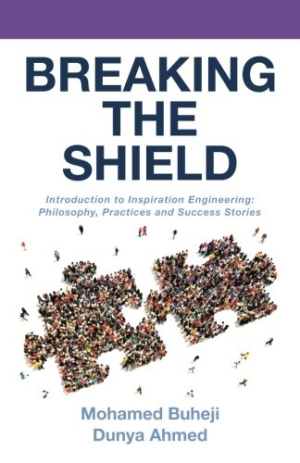Breaking the Shield
Introduction to Inspiration Engineering: Philosophy, Practices and Success Stories
Behavioral scientists, educators, and organizational leaders are all likely to benefit from this theoretical and practical text.
In their thorough book Breaking the Shield, Bahraini doctors Mohamed Buheji and Dunya Ahmed explain and explore the concept of “inspiration engineering.”
Buheji and Ahmed, the cofounders of the International Institute of Inspirational Economy, deliver a book that is perhaps most interesting because of its scientific, methodical approaches to inspiration—an attribute typically regarded as random if not accidental. The authors suggest that “inspiration engineering” already takes place in many organizations, but it is often informal and not labeled as such. They believe that inspiration can be systematically created by engineering “visualisations, observations, opportunities and discoveries.”
The book begins with a painstaking explanation of inspiration engineering as a concept. Then, it details the characteristics of individuals who could be seen as inspiration engineers. Particularly fascinating is the subsequent description of the “inspiration lab,” which is essentially a controlled environment where exploration can be conducted “without fear or boundaries until we come up with the best solution or possibilities.”
Since the uses of an inspiration lab could be quite varied, the book includes several case studies that demonstrate how the inspiration lab environment applies to very specific areas, such as social development programs or healthcare services.
The bulk of the book addresses the ways in which inspiration engineering can be useful. For example, one chapter discusses its applicability to problem solving, while another chapter describes inspiration engineering as it applies to building an entrepreneurial culture. The authors also talk about creating an “inspiration currency,” which refers not to money but rather to other valuable characteristics such as technical expertise or organizational knowledge. Again, specific case studies help make the abstract idea of inspiration currency more understandable.
The end of the book concentrates on applying inspiration engineering on a broader scale—for example, the authors show how to develop an “inspiring business model” and examine how inspiration labs can be used in governments. An extensive bibliography is included, along with appendices that provide further detailed information and real-world applications.
It should be pointed out that some of the material is challenging to understand. While this is due in part to the conceptual nature of inspiration engineering itself, the complexity of the subject matter and the formal use of language contribute to the level of comprehension difficulty. Grammatical errors hamper the book’s readability. On the positive side, numerous graphic charts help to explain the text, and the multiple case studies go a long way to demonstrate how inspiration engineering and inspiration labs can be put into practice.
From both a theoretical and a practical perspective, this book demonstrates very clearly that Buheji and Ahmed are expert authorities on the topic of inspiration engineering. Behavioral scientists, educators, and organizational leaders are all likely to benefit from Breaking the Shield.
Reviewed by
Barry Silverstein
Disclosure: This article is not an endorsement, but a review. The publisher of this book provided free copies of the book and paid a small fee to have their book reviewed by a professional reviewer. Foreword Reviews and Clarion Reviews make no guarantee that the publisher will receive a positive review. Foreword Magazine, Inc. is disclosing this in accordance with the Federal Trade Commission’s 16 CFR, Part 255.

